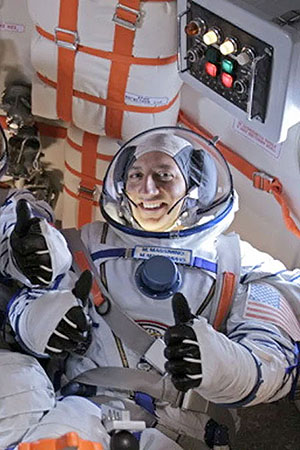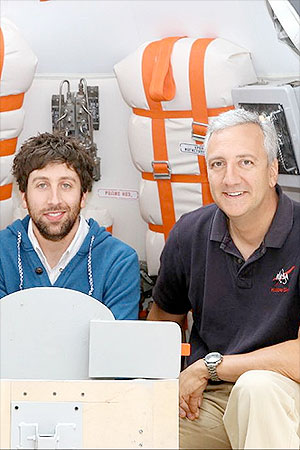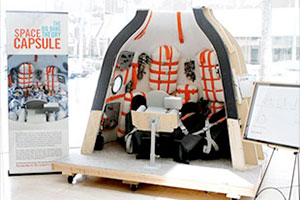May 10, 2012 — On Thursday evening's (May 10) season finale of "The Big Bang Theory," a main character on the CBS TV sitcom launches into space. Sitting beside him in the spacecraft is Mike Massimino, a real NASA astronaut, making his second cameo appearance on the show.
Massimino, who in real life flew twice on the space shuttle to upgrade the Hubble Space Telescope, joins aerospace engineer Howard Wolowitz, played by Simon Helberg, and a fictional cosmonaut as Expedition 31 crewmates aboard a Russian Soyuz capsule flying to the International Space Station.
The Soyuz and Sokol spacesuits the astronaut and actors board and wear are of course Hollywood replicas, but true to the show's reputation, are surprisingly realistic.
collectSPACE caught up with Massimino by phone a few hours before the episode was set to air to talk about being an astronaut on the show, the set and the future of space exploration, both for NASA and on "The Big Bang Theory."
collectSPACE (cS): This is your second time appearing on the show. Are you becoming a cast regular?
Michael Massimino: I don't think so. (laughs) I don't know. We'll see how it goes tonight.
cS: The Soyuz spacecraft set that they built was pretty impressive for TV. Were you impressed by how much attention to detail they gave?
Massimino: Yeah, it was incredible. The detail to the set, to the costumes — what we were going to wear — they wanted everything, the patches, the name tags that we were going to wear, every little detail to look as authentic as possible, and what we would be doing before the flight, during the countdown.
They really try to be very, very accurate in all their stuff, in all the science that they represent on the show. They have a consultant, a guy from UCLA, that helps them out for the science stuff. And then for this, they got a lot of help from NASA to make sure that the set, the costumes and all that stuff looked pretty accurate.
cS: You've flown on the space shuttle but you haven't yet flown on board the Soyuz. So were you part of the technical consultants for the set?
Massimino: Yeah, but as you say, I've never flown on the Soyuz. I know a little bit about the Soyuz but as I've never flown on it, the questions after awhile got to where I had no idea.
So I recruited some help from my friends, [astronauts and Soyuz crewmembers] Ron Garan and Mike Fossum. They helped answer a lot of the questions.
cS: So how long were you in the spacesuit and mock Soyuz?
Massimino: It was a few hours. It was kind like a real launch day, almost.
We arrived, got suited up and they even had a cooling unit for us, too. They were not real suits but they were pretty close replicas, as far as how they looked. They weren't as heavy as a real suit but they were still concerned about us getting overheated under the lights and everything. So, they gave us a cooling water bag to wear on our chests to help keep us cool. It was great.
We were in there, I guess, two-and-a-half to three hours in the suit and inside the mockup.
cS: So this could count for you towards training for a future flight on a Soyuz, right?
Massimino: I don't know about that! I mean I don't make that call, but it could certainly get you excited about going.
cS: How concerned were they about your dialog in the Soyuz? Or where you put your hands as compared to what would happen during an actual mission?
They wanted to know that as well, and that is where Ron Garan helped out, telling them the kind of conversations you'd have and it would be in Russian. You would speak Russian to the control center.
And even the hands were a big thing, too. Because they wanted to know what we would have as books and how you would hold the books. Ron helped them out with those questions.
cS: If you're allowed to say, is this the last we're going to see of the Soyuz, or you in the Soyuz?
Massimino: I don't know. I don't know what they are going to do. This was the season finale, so they don't know what they are going to do to start next season.
I did a media event last week with Bill Prady, one of the executive producers, and Simon Helberg, who's Wolowitz, and the entertainment media was asking Bill in particular what was going to happen. Is he going to be in space? And he was like, "We have no idea. We're on vacation."
So more or less, they're going to pick up their writing for the next season sometime over the summer and then they will figure it out. I think they really don't know. I think they are going to look at a few different options.
They could pick it up like it is the next day, or it could be the continuation of that day when they start their season again, or they could have the guy up in space, or they could have him return from space because it will be a few months between the last show of this season and the first show of next season.
It could be the very last we see of the Wolowitz-in-space saga or just be the beginning. They don't know yet, so I certainly don't know.
cS: What do you think is the value of something like this on television? Does it get the public more excited about real space exploration?
It's a good question and I've thought about this. I think what it is, and why NASA has supported this — not only sending me out there, but sending the information they need to help with their show and helping them in any way — is that they are trying to represent the space program in a very truthful light and that means a very positive light. That they are trying to educate people in some way about what is going on with our space program. So for that part of it, I think it is a good thing because it reminds people we still have people flying in space.
After the space shuttle program ended last summer, a lot of people — even people who live here in Houston — have asked me what am I doing now the space program is over. And I'm like, "Well, the space program is not over. We still have people flying, they're just not launching on the space shuttle to go to space."
"We're working with our friends, the Russians, but we are also planning to build our own spaceship and we're looking forward to the day we are able to launch again, not only on Soyuz but also on a US vehicle, whether it's a commercial vehicle or the NASA Orion vehicle or whatever."
So I think it is a way to get people aware that we're still in business. And even though the space shuttle program has ended, we still have a very active program with people on the space station. So I think it helps get that point out to a lot of people. There are so many millions of people who watch this show, the audience is so big, that it is a way for us to reach a lot of people that we would normally not be able to reach.
cS: Now they have some down time, have you invited the cast, Bill Prady and others out to Johnson Space Center to see your "set" — your workspace?
Massimino: Hah! They have an open invitation. They can come any time they like and I hope they are aware of that. We do have one of their producers coming in to see NASA, but that's just because he has family in the area and he'll be visiting.
I think they were invited to see a shuttle launch because one of the times I was on the set, they said they wished they had gotten a chance to go. They had been invited and they were going to try to go and they didn't and they were disappointed they didn't go. So hopefully, they'll have a chance to come and visit the Johnson Space Center and also maybe see some astronauts launch from Florida someday, hopefully not too many years from now.
But they are all very interested in the space program. The producers, the actors, the cast are just great. They really are fun people and very interested in NASA. The times I've been there on the set, they've introduced me to their families, they've brought their kids, their parents, to come say hi to an astronaut. It was kind of a big deal for them to be working with NASA. It's been a very nice relationship I think between the show and NASA.
cS: Now you've had a chance to sit in a mock Soyuz and work on a Hollywood set, if you had your choice, what would you like as your next assignment: another role in a sitcom or a flight to the International Space Station?
Either one of those things would be good but I don't really trust my Hollywood career as something I could actually sustain myself on. I think it is a fun thing to do and I think it's good for NASA but this acting thing, as fun as it is, I'm not quitting my day job. |
|

Veteran NASA astronaut Mike Massimino (right) poses for a photo with The Big Bang Theory actor Simon Helberg (left) and another actor during a break in filming the season finale. (Mike Massimino)

Veteran NASA astronaut Mike Massimino (right) poses for a photo with Big Bang Theory star Simon Helberg (center) and Executive Producer Bill Prady at the Paley Center in Los Angeles. (CBS)

The replica Soyuz Capsule built for the season finale of The Big Bang Theory, currently on display at the Paley Center. (CBS) |
